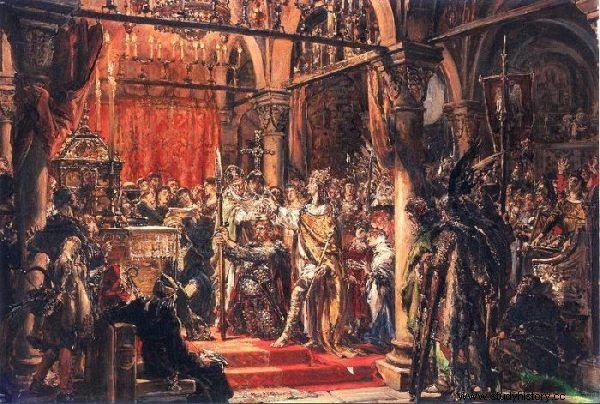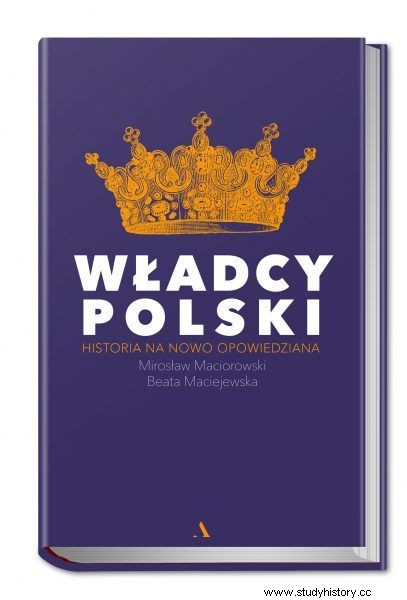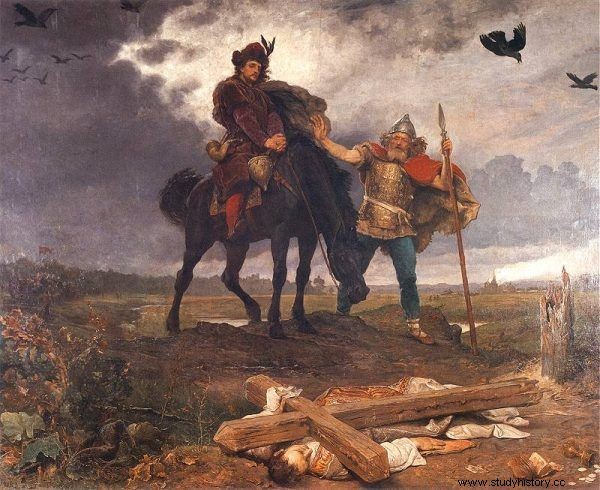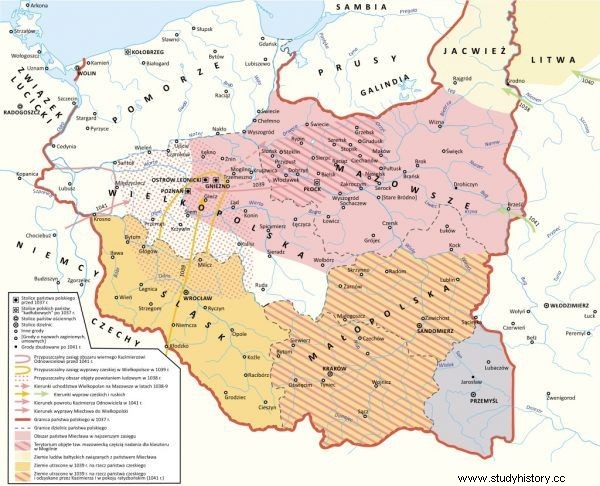In his childhood he witnessed the great triumphs of his grandfather and father, but then he felt the breakdown and collapse of their great-power politics. It was he who had to clean up the mess, restore the dynasty to power and rebuild the state almost from scratch. And he did it - but hardly anyone remembers about him today.
Kazimierz, later called the Restorer, was the son of Mieszko II and Rycheza, granddaughter of Emperor Otto II. He was born on July 25, 1016. At baptism, his middle name was given to Charles, because Riches was related to the Carolingians, and one of her ancestors was Charlemagne. In this way, the Piast dynasty symbolically emphasized its imperial connections.
Mieszko II and Rycheza lived in Kraków and, on behalf of Chrobry, they exercised the governorship in Małopolska. When Kazimierz was 10 years old, his parents gave him up to study. It probably took place in a school run by the Benedictines in Wawel. This later gave rise to the claims that the boy was perhaps being prepared for the clergy or monastic state.

Kazimierz most likely watched the coronation of his grandfather, Bolesław the Brave. Painting by Jan Matejko.
As a nine-year-old, the prince watched the coronation of his grandfather, Bolesław the Brave. Soon after, he attended his funeral, and still later his father's coronation. He was also a witness, and perhaps even a participant, of the successes of the parent in the first years of government. After them, however, bad times came for the Piasts. Initially, Mieszko II removed his brothers, Bezprym and Otto from power, and managed the state on his own. The others, however - in line with family practice - claimed theirs. They obtained armed help from the prince of Kiev, Jarosław the Wise, overthrew the king and forced him to flee the country.
The place of Mieszko II on the throne was taken by Bezprym. In order to gain recognition of his power by the emperor Conrad II, he resigned from the royal title and sent him the insignia. Rycheza, who also took Kazimierz with her from Poland, took them away. My uncle's bloody reign did not last long. He was murdered, and the rightful ruler, who regained the imperial support, returned to the country. Although he had to carve out a district for Otto and his cousin Dytryk, he managed to remove them over time. However, he did not enjoy the regained state for long - he died in 1034.
Poland ceased to exist…
Kazimierz returned to Poland in the last months of his father's life, and after his death, he assumed power. A difficult task awaited him. The country was devastated by invasions and internal struggles, plunged into chaos and cut down. A pagan popular uprising broke out in Greater Poland, directed against the Church and the powerful. In Pomerania, the power was taken over by the local dynasty. Grody Czerwienskie also broke away from the state. On the other hand, the teacup of Mieszko II, Miecław, ruled in Mazovia, who became independent and led to the separation of the district.
The problems of the new ruler did not end there. Probably the clerk from Mazovia liked the independence so much that he was inspired by the rebellion of the magnates. In 1037 or 1038 they expelled Kazimierz from the country. The Piast State, and with it the Polish Church, found themselves on the brink of a catastrophe. This is how he described the situation in the book “Władcy Polski. History re-told ”medievalist, professor Jerzy Wyrozumski:
The church was a new institution, still a stranger to many, and associated with tightening a screw. After all, in addition to the burden of maintaining the army and administration, tithing fell on the people. As long as the state was strong and successful, the people endured it. But the military crisis brought about the collapse of power structures and caused chaos.

The curiosity is based on the book by Mirosław Maciorowski and Beata Maciejowska, 'Władcy Polski. A story told anew ”(Agora 2018).
The exiled prince wanted to get to Germany, where his mother was still staying. He was going to ask the emperor for help. Unfortunately, he chose the route through Hungary. Meanwhile, the local king, Stephen I ... imprisoned him and took him prisoner! Kazimierz regained his freedom only after his death. The new monarch, Stefan Orseolo, allowed Piast to go and even provided him with 100 warriors.
As if that were not enough, the collapse of statehood, the lack of central authority and chaos in Poland decided to take advantage of the Czech prince Brzetyslaw I Przemyślid. In the summer of 1039, he set off to the north and took control of Greater Poland without much difficulty. He captured and burned down all the biggest castles - Poznań, Kruszwica and Gniezno. From the latter he took away the relics of Saint Adalbert, Bishop Radzim Gaudenty and the Five Martyrs, as well as numerous riches accumulated there by the Piast rulers.
The Czechs destroyed the cathedral in Gniezno and Poznań, plundered the prince's treasure, kidnapped many prisoners, and on their return they joined Silesia to their country. Gall Anonymous wrote: "And the cities mentioned for so long [Gniezno and Poznań - ed. PS] were abandoned, that in the church of St. Wojciech Męczennik and St. Peter the Apostle, wild animals found their lair ” .
Poland has hit rock bottom. It had no ruler, no administration, no army, and no Church destroyed by the Gentiles. It did not exist as a state. It seemed that the monarchy that had been painstakingly built over several generations of the Piasts had once and for all fallen into ruin.
With German help
However, there was someone who did not give up. Kazimierz, who finally reached Germany, gained access to Emperor Conrad II and his successor - Henry III thanks to the position of his mother. These rulers were getting ready for an expedition to Brzetyslav of Bohemia, so they wanted to gain an ally able to check Prague from the north. So Piast obtained political and armed aid. In late 1039 or early 1040, 500 knights headed for the country.

Kazimierz returned to the devastated country at the head of 500 knights.
Some historians believe that the expedition reached Poland from the west and the prince first occupied the Lubuskie region, then Greater Poland, and finally Lesser Poland. Others quote Gallus Anonymus who wrote that the recovery of the country began with "a certain town." They presume that it was probably Krakow, the city of the ruler's youth . It makes sense because Małopolska was not destroyed in the invasion of Brzetysław. Perhaps she had also missed the pagan reaction. So it was fit to be the center of the rebuilt state.
As a result, the center of the Piast power shifted from Greater Poland to the south for the first time in history. The district, in which until now the governor's power was customarily exercised by the sons of the ruler, has now been promoted to the rank of the main administrative center. And it stays that way.
Kazimierz the Forgotten
The prince vigorously set about recovering the remaining parts of his patrimony. First, he took the diplomatic route. He sought both the emperor and the pope to persuade Brzetysław of Bohemia to return looted relics, valuables and the captured Silesia.
When these efforts were unsuccessful, he resorted to more determined measures and tried several times to regain the lost land by force. He mastered it in 1050. Four years later, at the convention in Quedlinburg, Henry III agreed that she would stay with Poland, but at the price of an annual tribute paid to Prague.

Kazimierz saved Poland from almost complete disintegration. The shape of his country and the regained districts on the map.
To ensure support and peace on the eastern border, Kazimierz resorted to matrimonial diplomacy. He married the sister of the prince of Kiev, Jarosław the Wise, Dobroniega Maria. The marriage was accompanied by a political alliance, as part of which Kazimierz probably renounced the already lost Grody Czerwieńskie and sent 800 Ruthenian prisoners of war, still captured by Bolesław Chrobry, to Kiev. In return, the Russian ruler traveled to Poland to Mazovia to help his Polish brother-in-law get rid of the local warlord - Miecław.
In one of such expeditions, in 1047, there was a large battle on the Vistula (its exact place is unknown). Miecław's forces were smashed and he himself was killed. Another district has returned to the mother. Following the blow, the following year, Kazimierz set off for the Pomeranian people who supported his rival from Mazovia and the Czech Republic, hostile to Poland. He defeated the local prince Siemomysła and subjugated East Pomerania for some time.
The tireless prince also led the country's internal reconstruction. He renewed the bishoprics of Kraków and Wrocław, and raised destroyed churches from the rubble. He founded Benedictine monasteries in Kraków and Mogilno. He imported clergymen and church equipment from Germany. He also reformed the team's funding rules. As he explains in the book “Władcy Polski. History re-told ”professor Jerzy Wyrozumski:
He based them on land ownership - he gave it to warriors who, in return, were obliged to appear in defense of the state at the call of the ruler. This change was extremely important, it took place during the 11th and 12th centuries, and after its introduction, the army was actually financing itself . The foundations of chivalry law were created and developed in the following centuries .

Thanks to the support of Jarosław the Wise, Miecław was defeated.
Kazimierz did not crown himself. He died on March 19, 1058 in Poznań at the age of 42. Despite the fact that he rebuilt the Piast monarchy from extreme collapse, he was successful in the military, political and economic fields, Poles - including historians - do not remember him much. He was pushed into the shadows by such expressive rulers as Mieszko I, Bolesław the Brave or Bolesław Krzywousty, not to mention Jagiello and Sobieski.
And yet, as the authors of "The Lords of Poland" and their interlocutors emphasize, "everything indicates that was a cunning, stubborn and probably talented politician ". Why is so little talked about him? The reason is probably the small number of springs that have survived to our times. And also a phenomenon known for a long time, that hard work at the grassroots level is less spectacular than spectacular wars.
